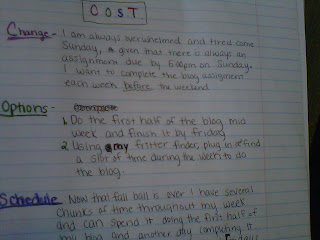I must make sure I start out with saying Happy Halloween to everyone because this is the most fun Holiday ever! With that being said, I knew that this weekend was going to challenging for me because I want to go out but have homework to do as well. Specifically I have been wanting and saying that my assignment for my CLS 105 class be completed before the weekend comes! Therefore, I used the strategy C.O.S.T. because I need to change that problem I kept running into. Also I used this in my SPA 101 class because my studying habits started to slowly go down the drain and I needed options and reinforcement to change them back. This strategy is easy and benefits you majorly!! Here is how you can do it:


C stands for change, so simply write down what you want to change and keep in mind these questions while you’re doing it: What is the source of your frustration? What do you want to happen?
O stands for Option, find your best option to helping you change! What are all of the possible options available to you that will result in change? There can be multiple. Which option is something you will ACTUALLY do?
S stands for Schedule, make a schedule to implement your option. When can you implement your best option. Will you need help implementing it?
T stands for Test, test your option to changing and see does the problem situation improve? Is the option working? Is change occurring? If not, should I try another option?
And wah-lah, change!
I color coordinated my letters, just because I am a visual learner and it helps me feel more organize. Also for schedule, I put it together with my fritter finder so that I could plan out specifically what time and day I was going to do my option. By recording down C.O.S.T., it gives you something to use as a record to help monitor your progress and see whether it is working or not. Also it helped me see my problem by actually putting it down onto paper more clear as apposed to continually saying I need to change this and that because then what is done? Nothing. This give you options of ways to change it! It’s awesome!

























